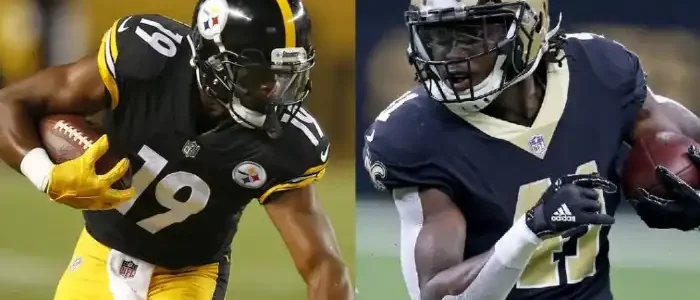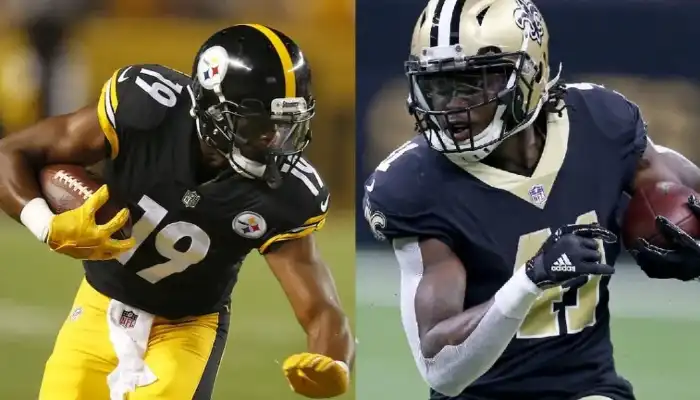
American football is a game of complex strategy and athletic ability. On offense, a well-oiled machine requires a symphony of positions working together to move the ball down the field and score points. The two most important roles in this offensive ballet are running backs and wide receivers. Though both help to contribute to adding up yards and touchdowns, their skill sets and obligations differ substantially. Knowing these differences is crucial in unmasking the complexity of the game.

Running Backs: The Ground Game Specialists
The running back is often called ‘the workhorse’ as he takes the handoff from the quarterback directly. They have main responsibilities that include:
- Rushing of Ball: Their major strength lies in carrying it through holes in an offensive line, avoiding defenders, and scoring yards on the ground.
- Pass Protection: A lot of times during passing plays, running backs play an important role in protecting quarterbacks by blocking against rushing defenders.
- Pass Catching: Modern-day running backs are increasingly being asked to do more than just run with the ball; they can line up everywhere on formation, catching passes coming out of the backfield, thus adding another dimension to any offense.
Different kinds of runners suit different types of offenses.
- Power Backs: Normally, these are bigger, stronger runners who can break tackles and get tough yardage.
- Speed Backs: These guys tend to be smaller, quick players with electric speed that could outrun defenders quickly enough for scores.
- Dual-Threat Backs: These players blend both styles, combining power with speed to provide balanced threats either through air or ground games.
Legendary running backs like Walter Payton, Emmitt Smith, and Adrian Peterson have captivated audiences with their power, vision, and elusiveness on the gridiron. Their ability to dominate in rushing competition along with finding the end zone has made them focal points of offenses and has put them in football history.
Wide Receivers: The Dynamic Playmakers
Wide receivers, often referred to as “air threats,” are the offensive players who line up on the outer edges of the formation and specialize in catching passes from the quarterback. Their primary responsibilities include:
- Route Running: Wideouts must be able to run many different routes downfield, moving just right to create separation from defenders and make space for a catch.
- Catching: When they snatch balls out of the air with tight coverage or dive forward for a first down, it takes sure hands and excellent hand-eye coordination.
- Yards After Catch (YAC): A good wide receiver can stretch plays by gaining extra yards after making the catch using their speed and agility.
Like running backs, there are different types of wide receivers:
- Deep Threats: These are incredibly fast receivers who specialize in streaking downfield and catching long passes for touchdowns.
- Possession Receivers: They’re reliable receivers who excel at running precise routes and catching passes consistently; they gain crucial first downs while moving chains.
- Slot Receivers are smaller, shiftier pass catchers that usually align themselves closer to the line of scrimmage; as a result, they can easily catch balls thrown short or inside spaces, avoiding tackles.
For example, iconic players like Jerry Rice, Randy Moss, and Marvin Harrison redefined the wide receiver position with their tantalizing and amazing route running, acrobatic catching, and enormous amounts of yards in one game. These passing game dominators have become offensive heroes and inductees into the annals of football history.
The Specialists: Key Differences Between Running Backs and Wide Receivers
Here are the key points of difference between Running Backs and Wide Receivers:
Role on the Field:
- Running Backs: Such players are those who work their way through every move, thereby holding on to the ball during rushed plays while avoiding being held down by defenders so that they can score. In addition to this, there is also a need for backs to block blitzes meant for the quarterback or catch balls thrown out from behind.
- Wide Receivers: These individuals excel at catching passes thrown by quarterbacks. They line up close to either end of a formation, which places them off the offense’s line. As a result, wide receivers rely on quickness when moving around corners and making catches beyond defenders’ reach.
Physical Attributes and Skill Sets:
- Running Backs: Being shorter than most widely spread out receivers, running backs tend to be more robust due to their blend of power, agility, and explosiveness. To navigate through tackles, they must have exceptional vision and balance, as well as the explosive speed required to outrun other players.
- Wide Receivers: Normally taller than many other players, these individuals value speed or quickness to outsprint defenders or separate themselves from defensive backs on their routes. On top of that, they possess outstanding leaping ability and the hand-eye coordination required for clutch catches made under tight coverage.
Tactical Usage by Coaches:
- Running Backs: According to offensive schemes implemented by coaches, running backs can be used differently. This implies that coaches can either feature them as the primary ball carriers during running plays or utilize them in short passing situations to exploit coverage weaknesses near the line of scrimmage.
- Wide Receivers: Offensive schemes often call for different types of wide receivers. In other words, a team could have a receiver who specializes in catching short-to-intermediate routes or one who is excellent at going deep.
Statistical Metrics for Performance Evaluation:
- Running Backs: Some key statistics about running backs include rushing yards, the number of touchdowns scored while rushing, receptions made during games, receiving yards, and their total yardage per carrier.
- Wide Receivers: Receiving yards, receiving touchdowns, receptions, and yards per reception determine a wide receiver’s performance.
The Common Ground: Similarities Between Running Backs and Wide Receivers
Below are points that show similarities between Running Backs and Wide Receivers:
Importance of Teamwork and Communication:
- Both receive great support from their teammates. An offensive line’s well-timed blocking creates gaps through which running backs can pass, while precise route-running allows the quarterbacks to throw accurately to open receivers.
Adaptability to Various Offensive Schemes:
- Today’s offenses require both running backs and wide receivers to be multi-faceted players. They should possess skills that allow them to assume diverse roles based on the call for play and the defense they face.
Role in Scoring Touchdowns and Gaining Yards:
- Irrespective of what they’re required to do as individuals, both running backs and wide receivers contribute towards achieving offensive success with their teams. This includes gaining ground either through air or on foot, ultimately touching down across goal lines.
The effect on the success of the whole team:
- An attacking team’s productivity can be greatly promoted by a moving and reciprocal dual featuring a halfback and a wide receiver. Through their joint ability, they execute well-planned moves that result in scoring goals for the team, thereby leading to their victory.
Conclusion
Running backs and wide receivers, although different in terms of assignment and specialty, are both pivotal in spearheading an offense. They become a formidable offensive force by combining their strengths in a way that complements one another, as well as efficient teamwork adaptation. Understanding these positions helps football fans gain deeper insights into the tactical war that plays out each time there is a huddle. This beginning could only lead to more; getting deep into offensive strategies and player dynamics will help you better appreciate what professional football represents on the field of play.

